Business Communication Report: Analysis and Recommendations
VerifiedAdded on 2023/01/19
|12
|2070
|1
Report
AI Summary
This report provides a comprehensive overview of business communication, encompassing both internal and external communication within an organization. It begins with an introduction to the importance of effective communication in achieving business success, followed by a literature review that explores the purpose and principles behind different forms of organizational communication, including formal, informal, written, and oral communication. The report delves into the principles of effective communication such as clarity, correctness, completeness, courtesy, consideration, and conciseness, emphasizing their role in fostering understanding and minimizing misunderstandings. Furthermore, it examines communication practices, highlighting how managers and employees can improve their communication skills through active listening, timely responses, and direct communication. The report analyzes the exchange of ideas, facts, and emotions within the organization, emphasizing the significance of proper and adequate communication for business growth and success, and it concludes by summarizing the key findings and reiterating the importance of communication as a crucial aspect of business operations.
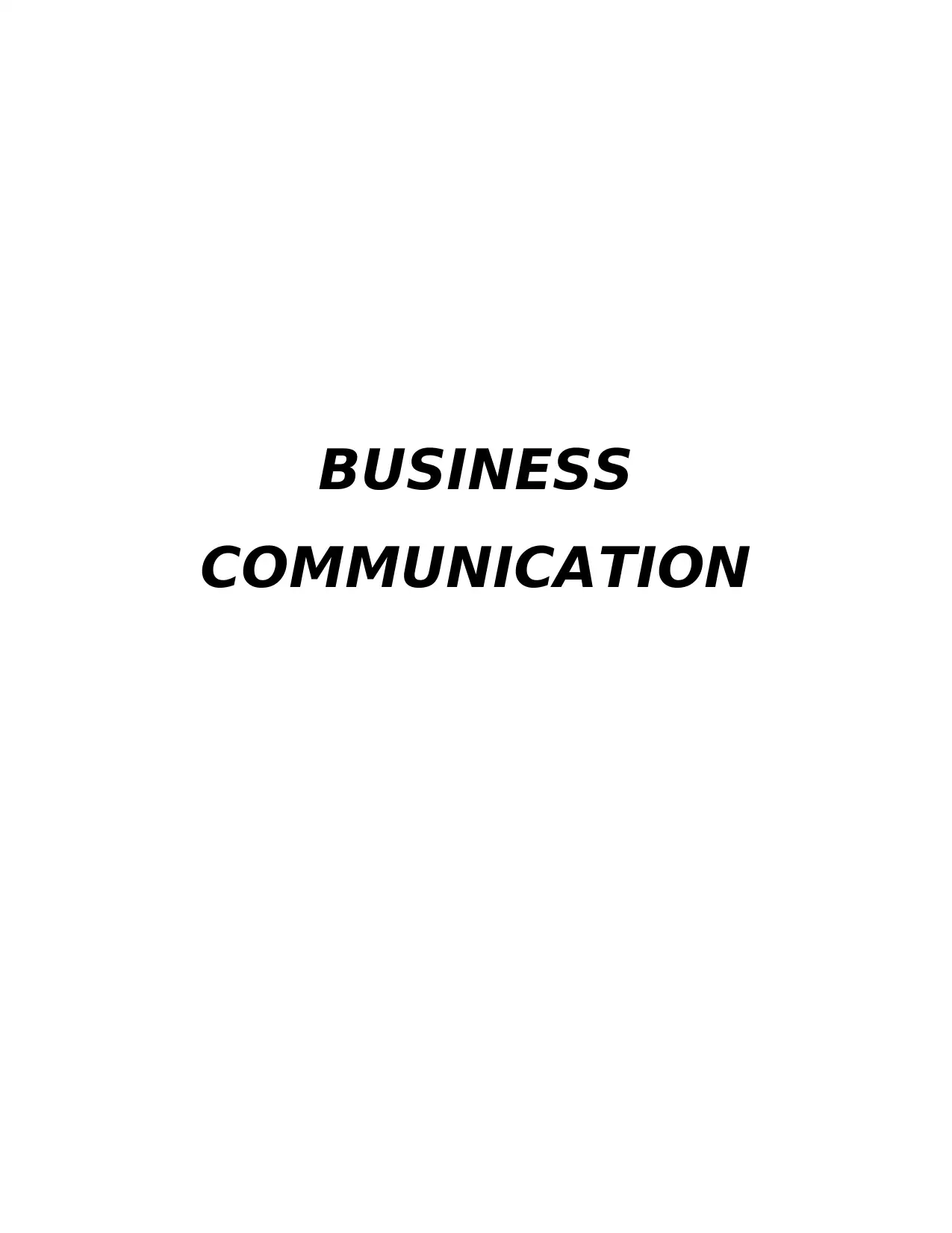
BUSINESS
COMMUNICATION
COMMUNICATION
Paraphrase This Document
Need a fresh take? Get an instant paraphrase of this document with our AI Paraphraser
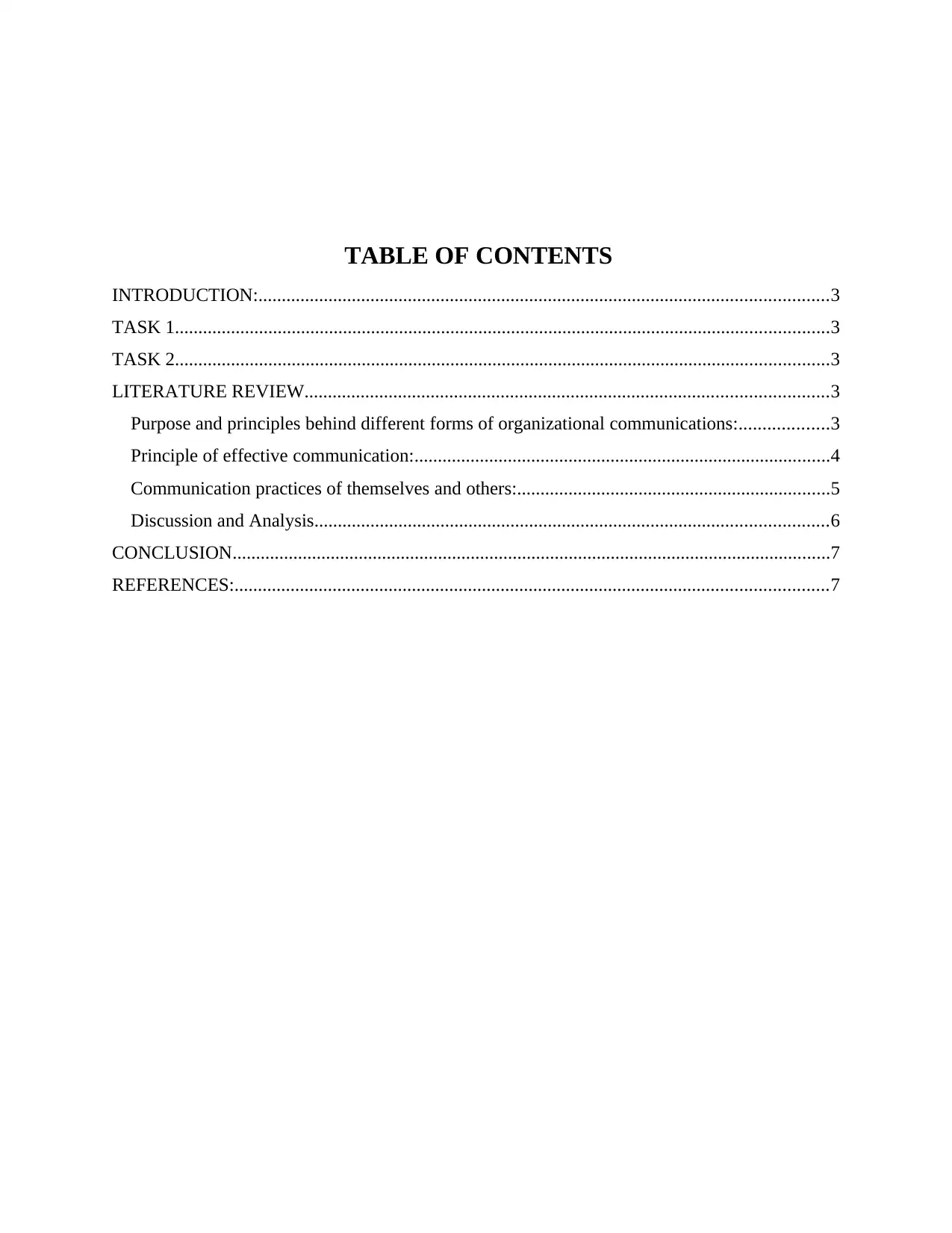
TABLE OF CONTENTS
INTRODUCTION:..........................................................................................................................3
TASK 1............................................................................................................................................3
TASK 2............................................................................................................................................3
LITERATURE REVIEW................................................................................................................3
Purpose and principles behind different forms of organizational communications:...................3
Principle of effective communication:.........................................................................................4
Communication practices of themselves and others:...................................................................5
Discussion and Analysis..............................................................................................................6
CONCLUSION................................................................................................................................7
REFERENCES:...............................................................................................................................7
INTRODUCTION:..........................................................................................................................3
TASK 1............................................................................................................................................3
TASK 2............................................................................................................................................3
LITERATURE REVIEW................................................................................................................3
Purpose and principles behind different forms of organizational communications:...................3
Principle of effective communication:.........................................................................................4
Communication practices of themselves and others:...................................................................5
Discussion and Analysis..............................................................................................................6
CONCLUSION................................................................................................................................7
REFERENCES:...............................................................................................................................7
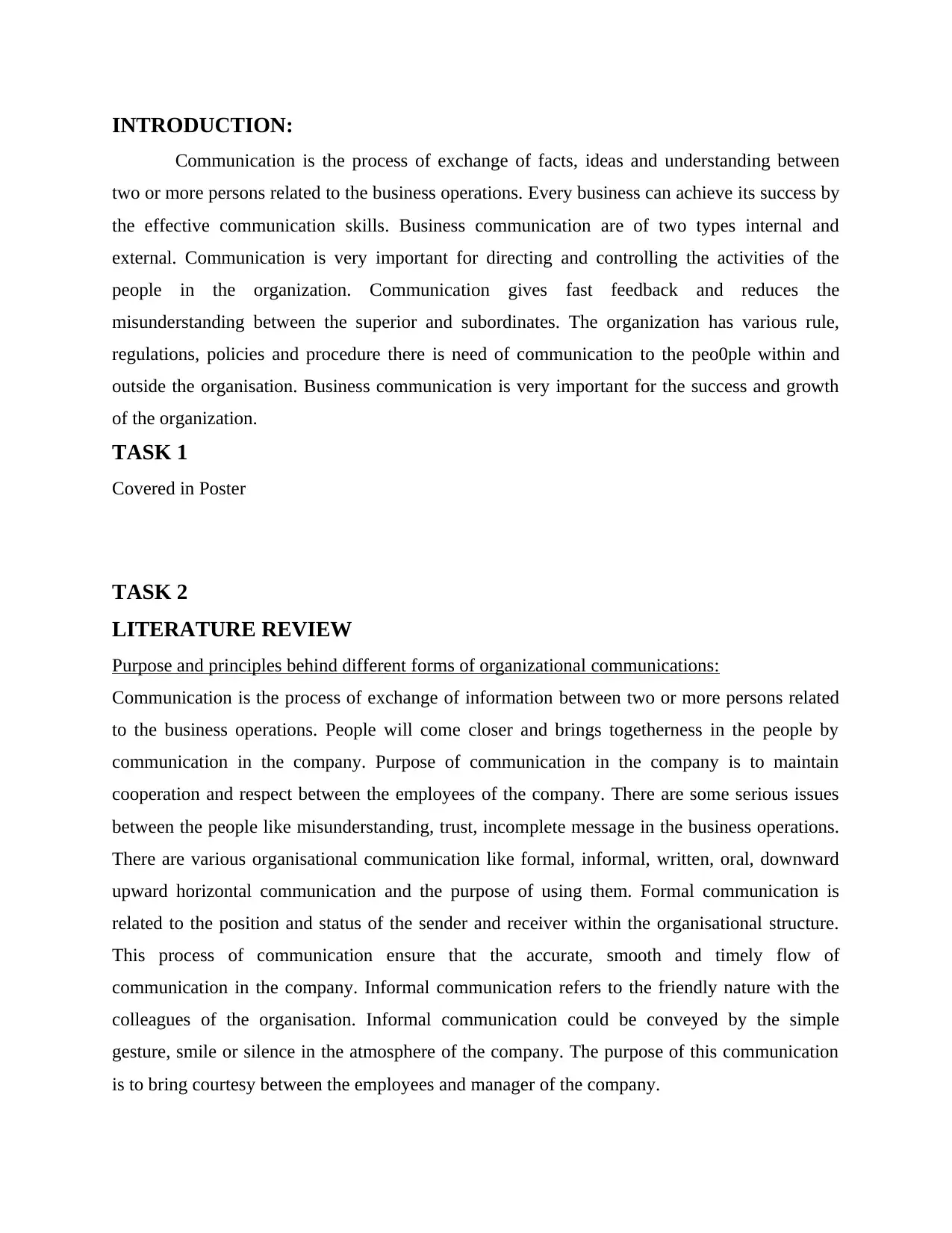
INTRODUCTION:
Communication is the process of exchange of facts, ideas and understanding between
two or more persons related to the business operations. Every business can achieve its success by
the effective communication skills. Business communication are of two types internal and
external. Communication is very important for directing and controlling the activities of the
people in the organization. Communication gives fast feedback and reduces the
misunderstanding between the superior and subordinates. The organization has various rule,
regulations, policies and procedure there is need of communication to the peo0ple within and
outside the organisation. Business communication is very important for the success and growth
of the organization.
TASK 1
Covered in Poster
TASK 2
LITERATURE REVIEW
Purpose and principles behind different forms of organizational communications:
Communication is the process of exchange of information between two or more persons related
to the business operations. People will come closer and brings togetherness in the people by
communication in the company. Purpose of communication in the company is to maintain
cooperation and respect between the employees of the company. There are some serious issues
between the people like misunderstanding, trust, incomplete message in the business operations.
There are various organisational communication like formal, informal, written, oral, downward
upward horizontal communication and the purpose of using them. Formal communication is
related to the position and status of the sender and receiver within the organisational structure.
This process of communication ensure that the accurate, smooth and timely flow of
communication in the company. Informal communication refers to the friendly nature with the
colleagues of the organisation. Informal communication could be conveyed by the simple
gesture, smile or silence in the atmosphere of the company. The purpose of this communication
is to bring courtesy between the employees and manager of the company.
Communication is the process of exchange of facts, ideas and understanding between
two or more persons related to the business operations. Every business can achieve its success by
the effective communication skills. Business communication are of two types internal and
external. Communication is very important for directing and controlling the activities of the
people in the organization. Communication gives fast feedback and reduces the
misunderstanding between the superior and subordinates. The organization has various rule,
regulations, policies and procedure there is need of communication to the peo0ple within and
outside the organisation. Business communication is very important for the success and growth
of the organization.
TASK 1
Covered in Poster
TASK 2
LITERATURE REVIEW
Purpose and principles behind different forms of organizational communications:
Communication is the process of exchange of information between two or more persons related
to the business operations. People will come closer and brings togetherness in the people by
communication in the company. Purpose of communication in the company is to maintain
cooperation and respect between the employees of the company. There are some serious issues
between the people like misunderstanding, trust, incomplete message in the business operations.
There are various organisational communication like formal, informal, written, oral, downward
upward horizontal communication and the purpose of using them. Formal communication is
related to the position and status of the sender and receiver within the organisational structure.
This process of communication ensure that the accurate, smooth and timely flow of
communication in the company. Informal communication refers to the friendly nature with the
colleagues of the organisation. Informal communication could be conveyed by the simple
gesture, smile or silence in the atmosphere of the company. The purpose of this communication
is to bring courtesy between the employees and manager of the company.
⊘ This is a preview!⊘
Do you want full access?
Subscribe today to unlock all pages.

Trusted by 1+ million students worldwide
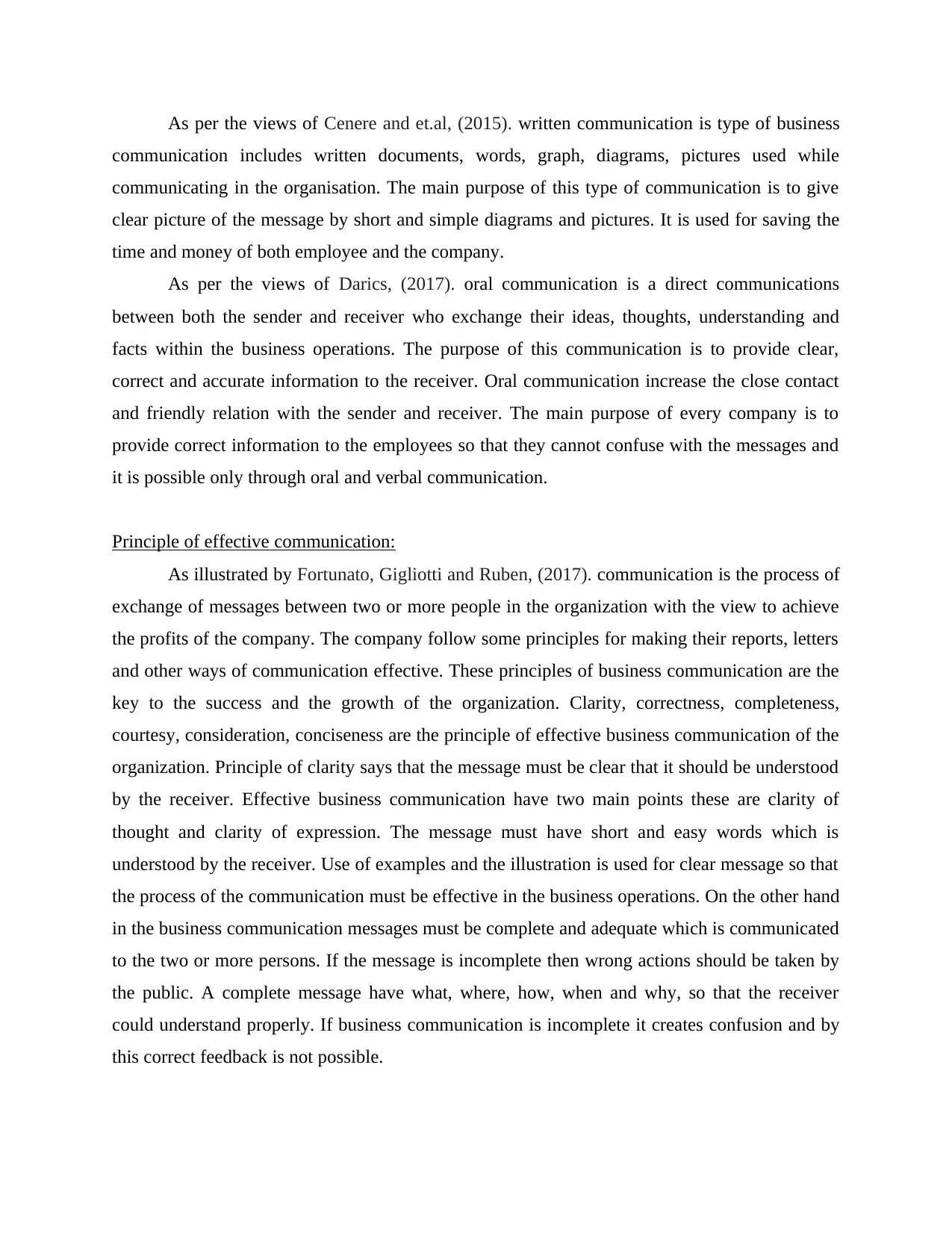
As per the views of Cenere and et.al, (2015). written communication is type of business
communication includes written documents, words, graph, diagrams, pictures used while
communicating in the organisation. The main purpose of this type of communication is to give
clear picture of the message by short and simple diagrams and pictures. It is used for saving the
time and money of both employee and the company.
As per the views of Darics, (2017). oral communication is a direct communications
between both the sender and receiver who exchange their ideas, thoughts, understanding and
facts within the business operations. The purpose of this communication is to provide clear,
correct and accurate information to the receiver. Oral communication increase the close contact
and friendly relation with the sender and receiver. The main purpose of every company is to
provide correct information to the employees so that they cannot confuse with the messages and
it is possible only through oral and verbal communication.
Principle of effective communication:
As illustrated by Fortunato, Gigliotti and Ruben, (2017). communication is the process of
exchange of messages between two or more people in the organization with the view to achieve
the profits of the company. The company follow some principles for making their reports, letters
and other ways of communication effective. These principles of business communication are the
key to the success and the growth of the organization. Clarity, correctness, completeness,
courtesy, consideration, conciseness are the principle of effective business communication of the
organization. Principle of clarity says that the message must be clear that it should be understood
by the receiver. Effective business communication have two main points these are clarity of
thought and clarity of expression. The message must have short and easy words which is
understood by the receiver. Use of examples and the illustration is used for clear message so that
the process of the communication must be effective in the business operations. On the other hand
in the business communication messages must be complete and adequate which is communicated
to the two or more persons. If the message is incomplete then wrong actions should be taken by
the public. A complete message have what, where, how, when and why, so that the receiver
could understand properly. If business communication is incomplete it creates confusion and by
this correct feedback is not possible.
communication includes written documents, words, graph, diagrams, pictures used while
communicating in the organisation. The main purpose of this type of communication is to give
clear picture of the message by short and simple diagrams and pictures. It is used for saving the
time and money of both employee and the company.
As per the views of Darics, (2017). oral communication is a direct communications
between both the sender and receiver who exchange their ideas, thoughts, understanding and
facts within the business operations. The purpose of this communication is to provide clear,
correct and accurate information to the receiver. Oral communication increase the close contact
and friendly relation with the sender and receiver. The main purpose of every company is to
provide correct information to the employees so that they cannot confuse with the messages and
it is possible only through oral and verbal communication.
Principle of effective communication:
As illustrated by Fortunato, Gigliotti and Ruben, (2017). communication is the process of
exchange of messages between two or more people in the organization with the view to achieve
the profits of the company. The company follow some principles for making their reports, letters
and other ways of communication effective. These principles of business communication are the
key to the success and the growth of the organization. Clarity, correctness, completeness,
courtesy, consideration, conciseness are the principle of effective business communication of the
organization. Principle of clarity says that the message must be clear that it should be understood
by the receiver. Effective business communication have two main points these are clarity of
thought and clarity of expression. The message must have short and easy words which is
understood by the receiver. Use of examples and the illustration is used for clear message so that
the process of the communication must be effective in the business operations. On the other hand
in the business communication messages must be complete and adequate which is communicated
to the two or more persons. If the message is incomplete then wrong actions should be taken by
the public. A complete message have what, where, how, when and why, so that the receiver
could understand properly. If business communication is incomplete it creates confusion and by
this correct feedback is not possible.
Paraphrase This Document
Need a fresh take? Get an instant paraphrase of this document with our AI Paraphraser
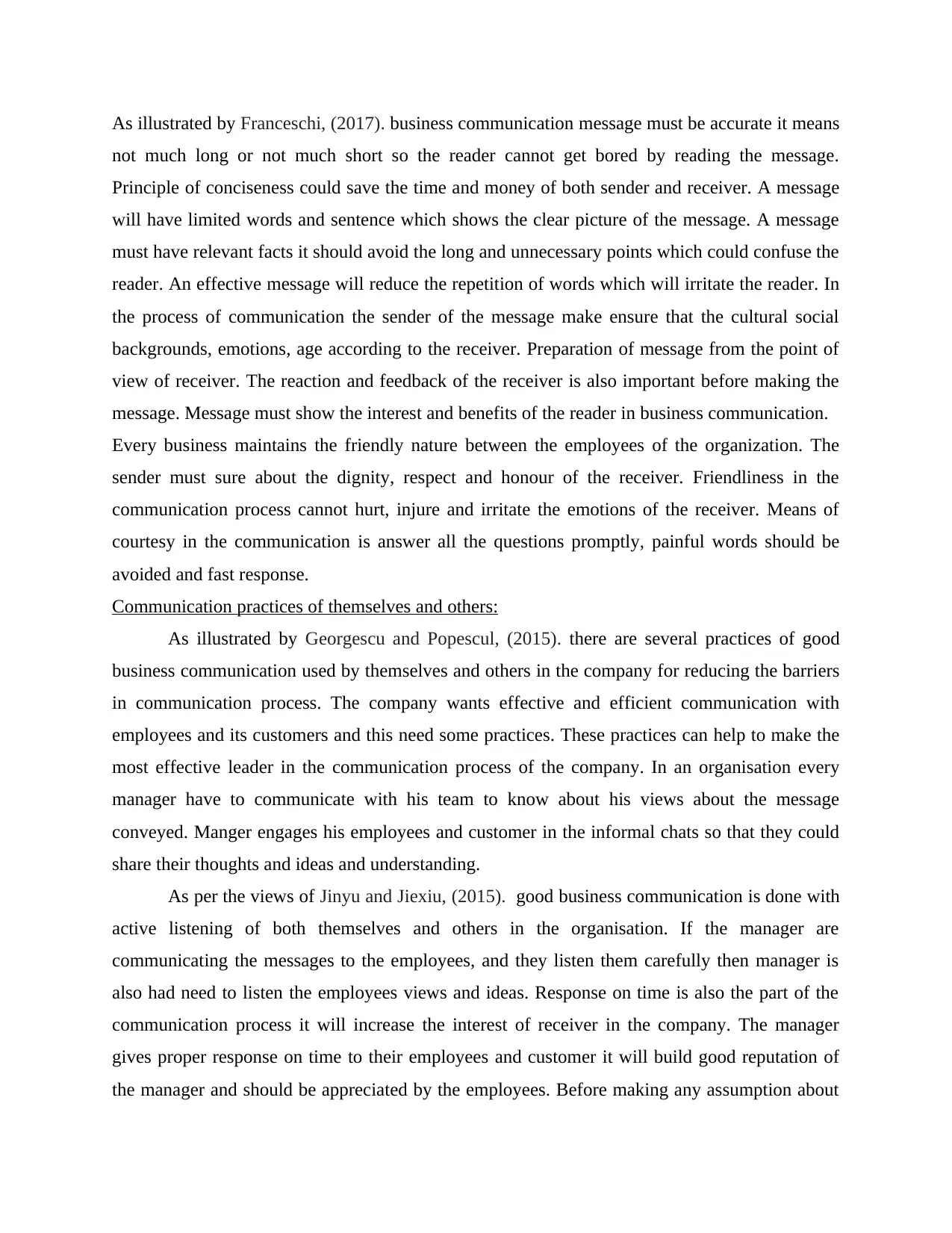
As illustrated by Franceschi, (2017). business communication message must be accurate it means
not much long or not much short so the reader cannot get bored by reading the message.
Principle of conciseness could save the time and money of both sender and receiver. A message
will have limited words and sentence which shows the clear picture of the message. A message
must have relevant facts it should avoid the long and unnecessary points which could confuse the
reader. An effective message will reduce the repetition of words which will irritate the reader. In
the process of communication the sender of the message make ensure that the cultural social
backgrounds, emotions, age according to the receiver. Preparation of message from the point of
view of receiver. The reaction and feedback of the receiver is also important before making the
message. Message must show the interest and benefits of the reader in business communication.
Every business maintains the friendly nature between the employees of the organization. The
sender must sure about the dignity, respect and honour of the receiver. Friendliness in the
communication process cannot hurt, injure and irritate the emotions of the receiver. Means of
courtesy in the communication is answer all the questions promptly, painful words should be
avoided and fast response.
Communication practices of themselves and others:
As illustrated by Georgescu and Popescul, (2015). there are several practices of good
business communication used by themselves and others in the company for reducing the barriers
in communication process. The company wants effective and efficient communication with
employees and its customers and this need some practices. These practices can help to make the
most effective leader in the communication process of the company. In an organisation every
manager have to communicate with his team to know about his views about the message
conveyed. Manger engages his employees and customer in the informal chats so that they could
share their thoughts and ideas and understanding.
As per the views of Jinyu and Jiexiu, (2015). good business communication is done with
active listening of both themselves and others in the organisation. If the manager are
communicating the messages to the employees, and they listen them carefully then manager is
also had need to listen the employees views and ideas. Response on time is also the part of the
communication process it will increase the interest of receiver in the company. The manager
gives proper response on time to their employees and customer it will build good reputation of
the manager and should be appreciated by the employees. Before making any assumption about
not much long or not much short so the reader cannot get bored by reading the message.
Principle of conciseness could save the time and money of both sender and receiver. A message
will have limited words and sentence which shows the clear picture of the message. A message
must have relevant facts it should avoid the long and unnecessary points which could confuse the
reader. An effective message will reduce the repetition of words which will irritate the reader. In
the process of communication the sender of the message make ensure that the cultural social
backgrounds, emotions, age according to the receiver. Preparation of message from the point of
view of receiver. The reaction and feedback of the receiver is also important before making the
message. Message must show the interest and benefits of the reader in business communication.
Every business maintains the friendly nature between the employees of the organization. The
sender must sure about the dignity, respect and honour of the receiver. Friendliness in the
communication process cannot hurt, injure and irritate the emotions of the receiver. Means of
courtesy in the communication is answer all the questions promptly, painful words should be
avoided and fast response.
Communication practices of themselves and others:
As illustrated by Georgescu and Popescul, (2015). there are several practices of good
business communication used by themselves and others in the company for reducing the barriers
in communication process. The company wants effective and efficient communication with
employees and its customers and this need some practices. These practices can help to make the
most effective leader in the communication process of the company. In an organisation every
manager have to communicate with his team to know about his views about the message
conveyed. Manger engages his employees and customer in the informal chats so that they could
share their thoughts and ideas and understanding.
As per the views of Jinyu and Jiexiu, (2015). good business communication is done with
active listening of both themselves and others in the organisation. If the manager are
communicating the messages to the employees, and they listen them carefully then manager is
also had need to listen the employees views and ideas. Response on time is also the part of the
communication process it will increase the interest of receiver in the company. The manager
gives proper response on time to their employees and customer it will build good reputation of
the manager and should be appreciated by the employees. Before making any assumption about
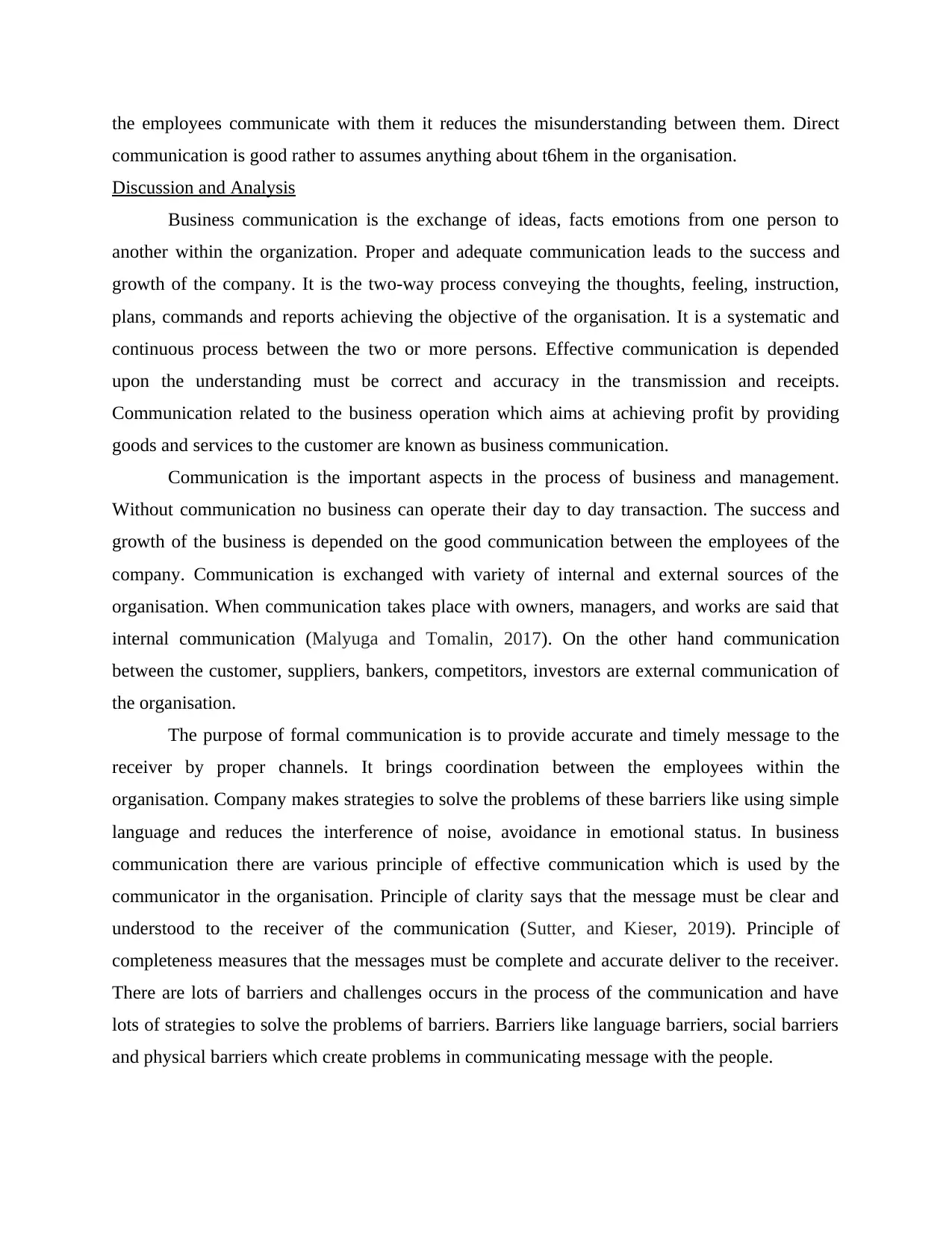
the employees communicate with them it reduces the misunderstanding between them. Direct
communication is good rather to assumes anything about t6hem in the organisation.
Discussion and Analysis
Business communication is the exchange of ideas, facts emotions from one person to
another within the organization. Proper and adequate communication leads to the success and
growth of the company. It is the two-way process conveying the thoughts, feeling, instruction,
plans, commands and reports achieving the objective of the organisation. It is a systematic and
continuous process between the two or more persons. Effective communication is depended
upon the understanding must be correct and accuracy in the transmission and receipts.
Communication related to the business operation which aims at achieving profit by providing
goods and services to the customer are known as business communication.
Communication is the important aspects in the process of business and management.
Without communication no business can operate their day to day transaction. The success and
growth of the business is depended on the good communication between the employees of the
company. Communication is exchanged with variety of internal and external sources of the
organisation. When communication takes place with owners, managers, and works are said that
internal communication (Malyuga and Tomalin, 2017). On the other hand communication
between the customer, suppliers, bankers, competitors, investors are external communication of
the organisation.
The purpose of formal communication is to provide accurate and timely message to the
receiver by proper channels. It brings coordination between the employees within the
organisation. Company makes strategies to solve the problems of these barriers like using simple
language and reduces the interference of noise, avoidance in emotional status. In business
communication there are various principle of effective communication which is used by the
communicator in the organisation. Principle of clarity says that the message must be clear and
understood to the receiver of the communication (Sutter, and Kieser, 2019). Principle of
completeness measures that the messages must be complete and accurate deliver to the receiver.
There are lots of barriers and challenges occurs in the process of the communication and have
lots of strategies to solve the problems of barriers. Barriers like language barriers, social barriers
and physical barriers which create problems in communicating message with the people.
communication is good rather to assumes anything about t6hem in the organisation.
Discussion and Analysis
Business communication is the exchange of ideas, facts emotions from one person to
another within the organization. Proper and adequate communication leads to the success and
growth of the company. It is the two-way process conveying the thoughts, feeling, instruction,
plans, commands and reports achieving the objective of the organisation. It is a systematic and
continuous process between the two or more persons. Effective communication is depended
upon the understanding must be correct and accuracy in the transmission and receipts.
Communication related to the business operation which aims at achieving profit by providing
goods and services to the customer are known as business communication.
Communication is the important aspects in the process of business and management.
Without communication no business can operate their day to day transaction. The success and
growth of the business is depended on the good communication between the employees of the
company. Communication is exchanged with variety of internal and external sources of the
organisation. When communication takes place with owners, managers, and works are said that
internal communication (Malyuga and Tomalin, 2017). On the other hand communication
between the customer, suppliers, bankers, competitors, investors are external communication of
the organisation.
The purpose of formal communication is to provide accurate and timely message to the
receiver by proper channels. It brings coordination between the employees within the
organisation. Company makes strategies to solve the problems of these barriers like using simple
language and reduces the interference of noise, avoidance in emotional status. In business
communication there are various principle of effective communication which is used by the
communicator in the organisation. Principle of clarity says that the message must be clear and
understood to the receiver of the communication (Sutter, and Kieser, 2019). Principle of
completeness measures that the messages must be complete and accurate deliver to the receiver.
There are lots of barriers and challenges occurs in the process of the communication and have
lots of strategies to solve the problems of barriers. Barriers like language barriers, social barriers
and physical barriers which create problems in communicating message with the people.
⊘ This is a preview!⊘
Do you want full access?
Subscribe today to unlock all pages.

Trusted by 1+ million students worldwide
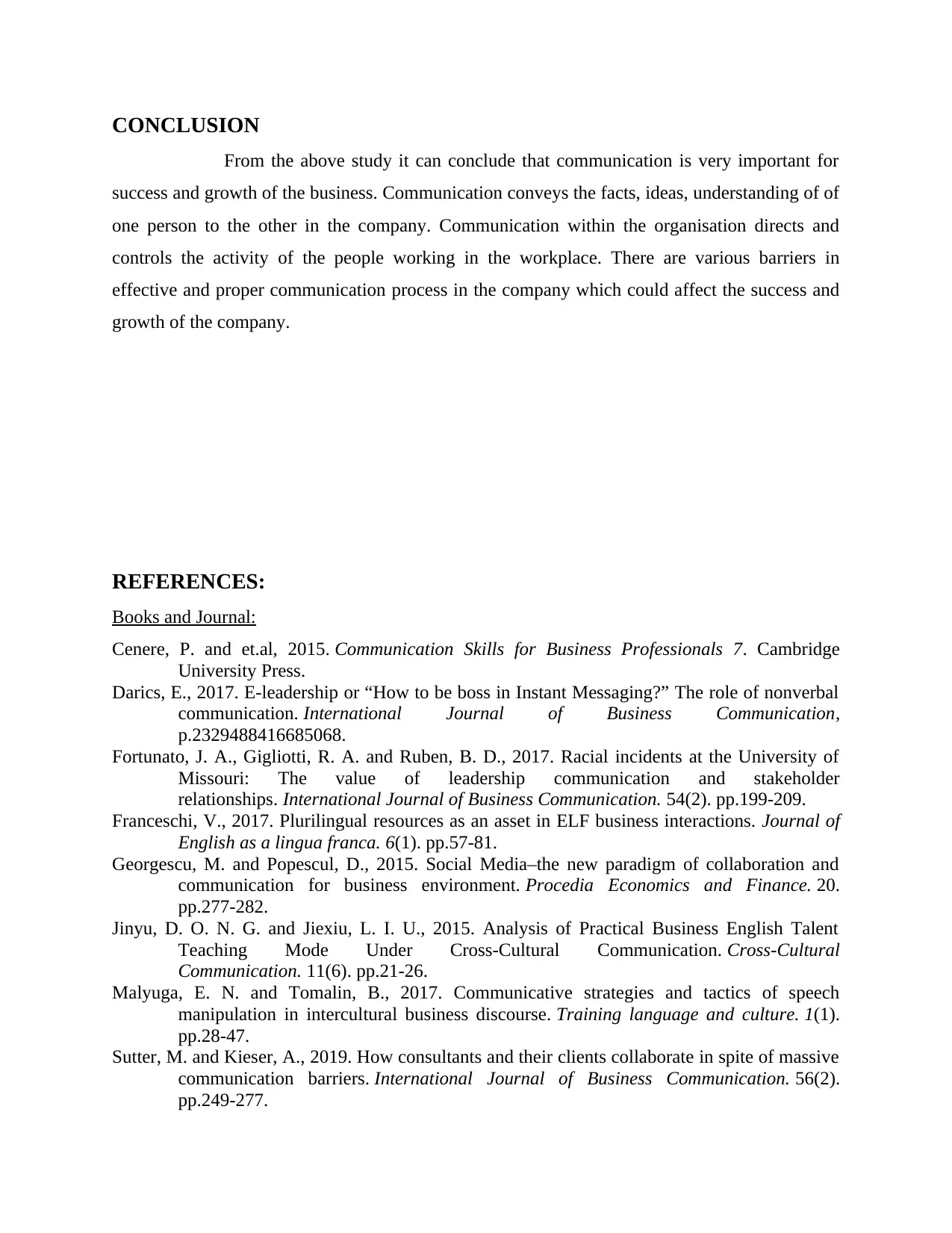
CONCLUSION
From the above study it can conclude that communication is very important for
success and growth of the business. Communication conveys the facts, ideas, understanding of of
one person to the other in the company. Communication within the organisation directs and
controls the activity of the people working in the workplace. There are various barriers in
effective and proper communication process in the company which could affect the success and
growth of the company.
REFERENCES:
Books and Journal:
Cenere, P. and et.al, 2015. Communication Skills for Business Professionals 7. Cambridge
University Press.
Darics, E., 2017. E-leadership or “How to be boss in Instant Messaging?” The role of nonverbal
communication. International Journal of Business Communication,
p.2329488416685068.
Fortunato, J. A., Gigliotti, R. A. and Ruben, B. D., 2017. Racial incidents at the University of
Missouri: The value of leadership communication and stakeholder
relationships. International Journal of Business Communication. 54(2). pp.199-209.
Franceschi, V., 2017. Plurilingual resources as an asset in ELF business interactions. Journal of
English as a lingua franca. 6(1). pp.57-81.
Georgescu, M. and Popescul, D., 2015. Social Media–the new paradigm of collaboration and
communication for business environment. Procedia Economics and Finance. 20.
pp.277-282.
Jinyu, D. O. N. G. and Jiexiu, L. I. U., 2015. Analysis of Practical Business English Talent
Teaching Mode Under Cross-Cultural Communication. Cross-Cultural
Communication. 11(6). pp.21-26.
Malyuga, E. N. and Tomalin, B., 2017. Communicative strategies and tactics of speech
manipulation in intercultural business discourse. Training language and culture. 1(1).
pp.28-47.
Sutter, M. and Kieser, A., 2019. How consultants and their clients collaborate in spite of massive
communication barriers. International Journal of Business Communication. 56(2).
pp.249-277.
From the above study it can conclude that communication is very important for
success and growth of the business. Communication conveys the facts, ideas, understanding of of
one person to the other in the company. Communication within the organisation directs and
controls the activity of the people working in the workplace. There are various barriers in
effective and proper communication process in the company which could affect the success and
growth of the company.
REFERENCES:
Books and Journal:
Cenere, P. and et.al, 2015. Communication Skills for Business Professionals 7. Cambridge
University Press.
Darics, E., 2017. E-leadership or “How to be boss in Instant Messaging?” The role of nonverbal
communication. International Journal of Business Communication,
p.2329488416685068.
Fortunato, J. A., Gigliotti, R. A. and Ruben, B. D., 2017. Racial incidents at the University of
Missouri: The value of leadership communication and stakeholder
relationships. International Journal of Business Communication. 54(2). pp.199-209.
Franceschi, V., 2017. Plurilingual resources as an asset in ELF business interactions. Journal of
English as a lingua franca. 6(1). pp.57-81.
Georgescu, M. and Popescul, D., 2015. Social Media–the new paradigm of collaboration and
communication for business environment. Procedia Economics and Finance. 20.
pp.277-282.
Jinyu, D. O. N. G. and Jiexiu, L. I. U., 2015. Analysis of Practical Business English Talent
Teaching Mode Under Cross-Cultural Communication. Cross-Cultural
Communication. 11(6). pp.21-26.
Malyuga, E. N. and Tomalin, B., 2017. Communicative strategies and tactics of speech
manipulation in intercultural business discourse. Training language and culture. 1(1).
pp.28-47.
Sutter, M. and Kieser, A., 2019. How consultants and their clients collaborate in spite of massive
communication barriers. International Journal of Business Communication. 56(2).
pp.249-277.
Paraphrase This Document
Need a fresh take? Get an instant paraphrase of this document with our AI Paraphraser


⊘ This is a preview!⊘
Do you want full access?
Subscribe today to unlock all pages.

Trusted by 1+ million students worldwide

Paraphrase This Document
Need a fresh take? Get an instant paraphrase of this document with our AI Paraphraser


⊘ This is a preview!⊘
Do you want full access?
Subscribe today to unlock all pages.

Trusted by 1+ million students worldwide
1 out of 12
Related Documents
Your All-in-One AI-Powered Toolkit for Academic Success.
+13062052269
info@desklib.com
Available 24*7 on WhatsApp / Email
![[object Object]](/_next/static/media/star-bottom.7253800d.svg)
Unlock your academic potential
Copyright © 2020–2025 A2Z Services. All Rights Reserved. Developed and managed by ZUCOL.





